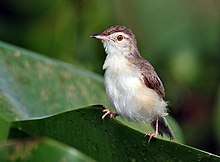Prinia
Prinia is a genus of small insectivorous birds belonging to the passerine bird family Cisticolidae. They were at one time classed in the Old World warbler family, Sylviidae.
| Prinia | |
|---|---|
_.jpg) | |
| Bar-winged prinia (Prinia familiaris) | |
| Scientific classification | |
| Kingdom: | Animalia |
| Phylum: | Chordata |
| Class: | Aves |
| Order: | Passeriformes |
| Family: | Cisticolidae |
| Genus: | Prinia Horsfield, 1821 |
| Species | |
|
See text | |
_in_Hyderabad_W_IMG_8738.jpg)

_eyeing_Lannea_coromandelica_fruit_W_IMG_7890.jpg)
The prinias are sometimes referred to as wren-warblers. They are a little-known group of the tropical and subtropical Old World, the roughly thirty species being divided fairly equally between Africa and Asia.
These are birds mainly of open habitats such as long grass or scrub, in which they are not easily seen. They are mainly resident, migration being limited to local cold weather movements. Non-breeding birds may form small flocks.
Prinias have short wings but long tapering tails. They are fairly drab birds, brown or grey above (sometimes with dark streaks) and whitish below. Some species have different breeding and non-breeding plumages. The bill is a typical insectivore's, thin and slightly curved.
Taxonomy
The genus was erected by the American naturalist Thomas Horsfield in 1821. The type species is the bar-winged prinia (Prinia familiaris).[1][2] The name of the genus is derived from the Javanese prinya, the local name for the bar-winged prinia.[3]
A molecular phylogenetic study of the Cisticolidae published in 2013 found that the rufous-vented grass babbler did not lie within the clade containing the other prinias.[4] Based on this analysis the rufous-vented prinia and the closely related swamp grass babbler were moved to the reinstated genus Laticilla in the family Pellorneidae.[5]
Species
The genus contains 27 species:[5][6]
- Himalayan prinia, Prinia crinigera – formerly striated prinia
- Red-winged prinia, Prinia erythroptera
- Red-fronted prinia, Prinia rufifrons
- Swinhoe's prinia, Prinia striata – split from P. crinigera
- Deignan's prinia, Prinia polychroa – formerly brown prinia
- Burmese prinia, Prinia cooki – split from P. polychroa
- Annam prinia, Prinia rocki – split from P. polychroa
- Black-throated prinia, Prinia atrogularis
- Hill prinia, Prinia superciliaris
- Grey-crowned prinia, Prinia cinereocapilla
- Rufous-fronted prinia, Prinia buchanani
- Rufescent prinia, Prinia rufescens
- Grey-breasted prinia, Prinia hodgsonii
- Graceful prinia, Prinia gracilis
- Jungle prinia, Prinia sylvatica
- Bar-winged prinia, Prinia familiaris
- Yellow-bellied prinia, Prinia flaviventris
- Ashy prinia, Prinia socialis
- Tawny-flanked prinia, Prinia subflava
- Plain prinia, Prinia inornata
- Pale prinia, Prinia somalica
- River prinia, Prinia fluviatilis
- Black-chested prinia, Prinia flavicans
- Karoo prinia, Prinia maculosa
- Drakensberg prinia, Prinia hypoxantha
- São Tomé prinia, Prinia molleri
- Banded prinia, Prinia bairdii
Species formerly in Prinia but now considered distinct enough to warrant separate generic treatment:
- Sierra Leone prinia, Schistolais leontica
- White-chinned prinia, Schistolais leucopogon
Species formerly in Prinia but now moved to Laticilla in family Pellorneidae:[4]
- Rufous-vented grass babbler, Laticilla burnesii
- Swamp grass babbler, Laticilla cinerascens
References
| Wikimedia Commons has media related to Prinia. |
| Wikispecies has information related to Prinia |
- Horsfield, Thomas (1821). "Systematic arrangement and description of birds from the Island of Java". Transactions of the Linnean Society of London. 13: 133–200 [165]. doi:10.1111/j.1095-8339.1821.tb00061.x. Title page dated 1822
- Mayr, Ernst; Cottrell, G. William, eds. (1986). Check-list of Birds of the World. Volume 11. Cambridge, Massachusetts: Museum of Comparative Zoology. p. 128.
- Jobling, James A. (1991). A Dictionary of Scientific Bird Names. Oxford: Oxford University Press. p. 189. ISBN 0-19-854634-3.
- Olsson, U.; Irestedt, M.; Sangster, G.; Ericson, P.G.P.; Alström, P. (2013). "Systematic revision of the avian family Cisticolidae based on a multi-locus phylogeny of all genera". Molecular Phylogenetics and Evolution. 66 (3): 790–799. doi:10.1016/j.ympev.2012.11.004. PMID 23159891.
- Gill, Frank; Donsker, David, eds. (2017). "Grassbirds, Donacobius, Malagasy warblers, cisticolas & allies". World Bird List Version 7.3. International Ornithologists' Union. Retrieved 26 August 2017.
- Alström, Per; Rasmussen, Pamela C.; Sangster, George; Dalvi, Shashank; Round, Philip D.; Zhang, Ruying; Yao, Cheng-Te; Irestedt, Martin; Manh, Hung Le (2019). "Multiple species within the Striated Prinia Prinia crinigera-Brown Prinia P. polychroa complex revealed through an integrative taxonomic approach". Ibis. 0 (ja). doi:10.1111/ibi.12759. ISSN 1474-919X.
- Nguembock B.; Fjeldsa J.; Tillier A.; Pasquet E. (2007): A phylogeny for the Cisticolidae (Aves: Passeriformes) based on nuclear and mitochondrial DNA sequence data, and a re-interpretation of a unique nest-building specialization. Molecular Phylogenetics and Evolution 42: 272–286.
- Ryan, Peter (2006). Family Cisticolidae (Cisticolas and allies). pp. 378–492 in del Hoyo J., Elliott A. & Christie D.A. (2006) Handbook of the Birds of the World. Volume 11. Old World Flycatchers to Old World Warblers Lynx Edicions, Barcelona ISBN 978-84-96553-06-4
- Urban, E.K.; Fry, C.H. & Keith, S. (1997) The Birds of Africa, vol. 5. Academic Press, London. ISBN 0-12-137305-3